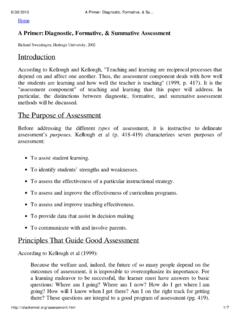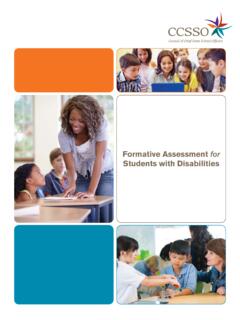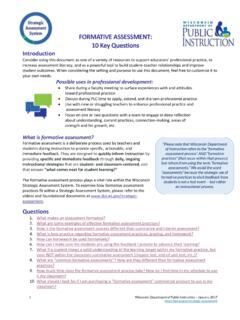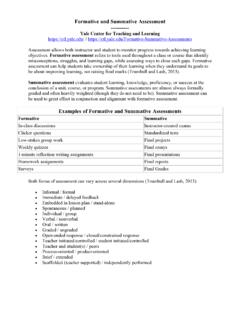Transcription of Second Language Assessment for Classroom Teachers - ed
1 1 Paper presented at MIDTESOL 2012, Ames, Iowa Second Language Assessment for Classroom Teachers Thu H. Tran Missouri University of Science and Technology Rolla, Missouri, USA Abstract The vast majority of Second Language Teachers feels confident about their instructional performance and does not usually have much difficulty with their teaching thanks to their professional training and accumulated Classroom experience. Nonetheless, many Second Language Teachers may not have received sufficient training in test development to design sound Classroom Assessment tools. The overarching aim of this paper is to discuss some fundamental issues in Second Language Assessment to provide Classroom practitioners with knowledge to improve their test development skills. The paper begins with the history, importance, and necessity of Language Assessment . It then reviews common terms used in Second Language Assessment and identifies categories and types of assessments.
2 Next, it examines major principles for Second Language Assessment including validity, reliability, practicality, equivalency, authenticity, and washback. The paper also discusses an array of options in Language Assessment which can generally be classified into three groups: selected-response, constructed-response, and personal response. Finally, the paper argues for a balanced approach to Second Language Assessment which should be utilized to yield more reliable Language Assessment results, and such an approach may reduce students stress and anxiety. (This paper contains one table.) 2 Paper presented at MIDTESOL 2012, Ames, Iowa The History of Language Assessment It may be difficult to find out when Language Assessment was first employed. The Old Testament, however, described an excellent example of one of the earliest written documents related to some kind of Language Assessment , as noted by Hopkins, Stanley, and Hopkins (1990).
3 The Gileadites took the fords of the Jordan toward Ephraim. When any of the fleeing Ephraimites said, Let me pass, the men of Gilead would say to him, Are you an Ephraimite? If he answered, No! they would ask him to say shibboleth. If he said sibboleth, not being able to give the proper pronunciation, they would seize him and kill him at the fords of Jordan. [Judges 12:5-6] The description above in the Bible may be considered one of the most extreme forms of high-stakes tests in the history of Language testing. The pronunciation test depicted is fairly clear. Being able to pronounce the h sound in the word shibboleth meant that one was Gileadite, and his life would be saved. Otherwise, he would be killed. These days Language Assessment is of importance as it is employed in a variety of contexts for various purposes and with different measuring devices and methods to help determine the level of Language proficiency of learners.
4 Decisions based on Language proficiency Assessment may at times have important implications on students academic and professional lives. The Importance and Necessity of Assessment In the field of education, some form of Assessment is inevitable; it is inherent in the teaching learning process (Hopkins, Stanley, & Hopkins, 1990, ). In a similar vein, Stoynoff and Chapelle (2005) stated that Teachers are involved in many forms of Assessment and testing through their daily teaching and use of test scores (p. 1), but they also noted that many Teachers find principles of Assessment an aspect that is difficult to update and apply efficiently. 3 Paper presented at MIDTESOL 2012, Ames, Iowa These authors also indicated that although Teachers can construct tests and test specialists can teach classes, the roles and daily activities of the two groups are different. Although the roles of Teachers and testers are clearly differentiated, it is almost impossible to assess students academic progress without Teachers .
5 In effect, Hopkins, Stanley, and Hopkins (ibid) noted that Classroom Teachers play a constant evaluative role (p. 194) because they have to attempt to decide on students degree of scholastic achievement and growth. In reality, Teachers working in institutions where there are no standardized or institutionally prepared tests have to construct their own tests for their classes, and when it is the case, the tests constructed by Teachers may not be as well designed as those written by professional testers. The author of this paper conducted a small scale survey of the top 10 programs that provide Master s Degree in Teaching English to Speakers of Other Languages (MA TESOL) in the United States by Google search and it was found that only four of the programs provided a course on Language Assessment or evaluation as a required course and one offered a course on assessing English Language learners as an elective course.
6 Half of the MA TESOL programs surveyed did not provide any courses related to Language Assessment or evaluation. Coombe, Folse, and Hubley (2007) might have been correct in observing that Assessment is foreign territory for many Teachers . It is, therefore, of great importance and necessity to provide Second Language Classroom practitioners with some fundamental principles and methods of testing, as not all TESOL Classroom practitioners are formally trained in Second Language Assessment . Even when Teachers are trained in Language Assessment , keeping abreast of current developments in Second Language Assessment can be a challenge. The primary purpose of this paper is to discuss the principles of Assessment and major Language Assessment types and 4 Paper presented at MIDTESOL 2012, Ames, Iowa options to enable Classroom Language Teachers to have a better understanding of constructing effective Classroom tests. Assessment Terminology Common terms Teachers are familiar with may be measurement, test, evaluation, and Assessment .
7 The aforementioned terms may informally be used interchangeably to refer to the practice of determining learners Language proficiency in a variety of contexts. However, Bachman (1990) defined measurement in the social sciences as the process of quantifying the characteristics of persons according to explicit procedures and rules (p. 18). In education, measurement is the process of quantifying the observed performance of Classroom learners (Brown & Abeywickrama, 2010, p. 4). Brown and Abeywickrama also mentioned that students performance can be described both quantitatively and qualitatively, or by assigning numbers such as rankings and letter grades or by providing written descriptions, oral feedback and narrative report. Drawing from the definition from Carroll (1968), Bachman (ibid) stated that a test is a measurement instrument designed to elicit a specific sample of an individual s behavior (p. 20). Similarly, Brown and Abeywickrama (2010) saw tests as a way of measuring a person s ability, knowledge, or performance in a specific domain.
8 Citing from Weiss (1972), Bachman (ibid) noted that evaluation can be defined as the systematic gathering of information for the purpose of making decisions ( ). Bachman (ibid) also added that one part of evaluation is the collection of reliable and relevant information (p. 22). Evaluation involves the interpretation of testing results used to make decisions (Brown & Abeywickrama, 2010). The example provided by Brown and Abeywickrama (ibid) is that if a 5 Paper presented at MIDTESOL 2012, Ames, Iowa student achieves a score of 75 percent (measurement) on a final Classroom examination, he or she may be told that the score resulted in a failure (evaluation) to pass the course ( ). Mihai (2010) asserted that Assessment is much more than tests and test scores (p. 22). Assessment , according to Mihai, is a combination of all kinds of formal and informal judgments and findings occurring inside and outside a Classroom .
9 In An Encyclopedic Dictionary of Language Testing, Mousavi (2009, p. 36) defined Assessment as appraising or estimating the level or magnitude of some attribute of a person. Assessment , as Brown and Abeywickrama (2010) added, is an ongoing process including a wide range of techniques such as simply making an oral appraisal of a student s response or jotting down a phrase to comment on a student s essay. Brown and Abeywickrama (ibid) also stated that a good teacher never ceases to assess students, whether those assessments are incidental or intended (p. 3). Categories of Evaluation and Assessments Evaluation In discussing about Language program evaluation, Richards (2001) presented three types of evaluation: formative , illuminative, and summative evaluation. formative evaluation, as Richards pointed out, is utilized to find out the aspects of a program that are working well, not working well, and issues that need to be addressed.
10 Some questions related to formative evaluation may involve seeking to find out if enough time has been spent on certain objectives or if the learning materials are well received. For Classroom Teachers , formative evaluation is an ongoing formal or informal evaluative process in which students are provided with various types of quizzes or tests which serve as a means for student learning. Illuminative evaluation, according to Richards, is employed to find out how different aspects of a program are implemented and this type of evaluation is one way to seek to have a deeper understanding of 6 Paper presented at MIDTESOL 2012, Ames, Iowa the process of teaching and learning that occur in the program, without necessarily seeking to change the course in any way as a result (ibid, p. 289). According to Passerini and Granger (2000), illuminative evaluations disclose important factors and issues emerging in a particular learning situation, factors which might have been overlooked by the instructor ( ).














